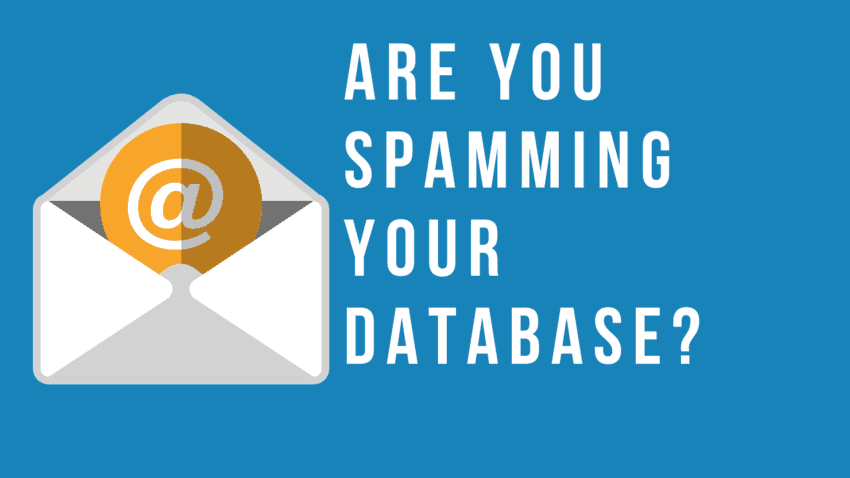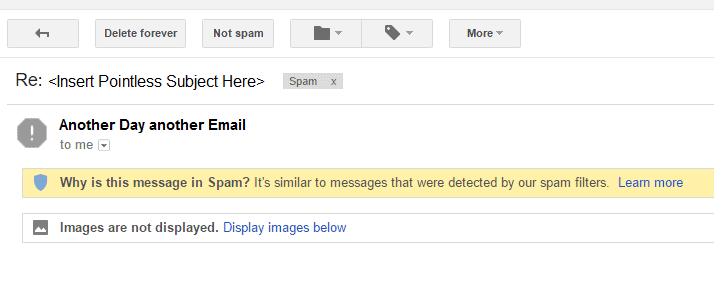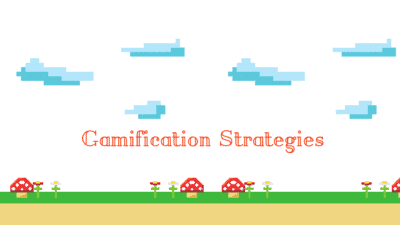Are you spamming your database?

As marketers, our number one priority is to support the sales’ pipeline and help deals close. Often, we’re asked to perform magic with no budget, time, or resources. If the magic works, we’re often the unsung heroes. If it doesn’t….well, we’ve all seen how that can play out, too.
Many times, we end up emailing our database with everything we’ve got to try to squeeze out another SQL. But, how much email is too much? How are you supposed to know if you’re spamming your database?

What is SPAM anyway?
SPAM is a spiced ham lunch meat that was introduced during WWII that many people still enjoy to this day. In addition to that, in regards to email, it also derives from the term “CAN-SPAM” — Controlling the Assault of Non-Solicited Pornography and Marketing. Basically, SPAM is any non-personal email you send to someone with without their consent.
How much email is too much email?
It doesn’t take a lot to be marked as SPAM. In fact, even if you have a list that consists only of double-opt in email addresses, you still run the risk of being marked as SPAM. Why? Because SPAM is in the eye of the beholder.
Every person is different. Every person is going to have their own determination on how much is too much. So how do you determine it?
Take a look at your personal email account. In the last week, how many mailing lists have you unsubscribed from that purposefully subscribed to in the past? Why did you do it? Now, take another look at your personal account. How many emails from the same company do you delete without opening them every month? Why did you stop opening them?
The number one reason people give is because they get too many emails. Now, you may say “well that’s my personal account, work email is different.” That’s true. With work email, you have the same person that’s fed up over receiving too many emails. But instead of them being at home spending some time surfing the web and checking email, you have someone who’s fed up AND is on the clock. They’re busy, and they do not have any time for this junk.
So, what do you do?
Eliminate Fluff Email
The first step is to stop sending them junk. Your emails may be witty and funny and nice but take a look before you hit “Send” and answer these questions:
- Does the email provide real value to the recipient?
If the email doesn’t provide the recipient value, don’t send it. If you read the email and don’t think your Contact will get real help out of your how-to guide or really be interested in your new blog post, don’t send it. Emails that don’t actually provide value to a Contact only actually give them another opportunity to unsubscribe or mark you as SPAM. - Does it solve a problem or help them in some way?
Similar to the previous question, this means that they need to get something out of your email and make sure they understand the point of the email. For example, maybe you want them to download the latest version of your software. That’s all well and good, but people don’t really care about what you want — make it focused on what they want. Does your new software minimize crashing or help improve battery life? Let them know how this email takes care of those things by providing them with the new software at their fingertips. - Is it something you’ve sent them before?
Re-using content is great. You’ve invested time, money, and resources into creating great content, and you should absolutely re-purpose it as much as you can. That being said, if you’ve sent a contact the same video in several different emails and they’ve never opened or clicked, it might be time to give it a rest. Your approach isn’t working, and what you’re offering, they’re not interested in. Instead, rotate in some new content. Promote your blog, your resources page, or even your Youtube channel.
Don’t send daily. Just don’t.
Unless you warn someone when they opt in or in the first email you send that you’re going to send emails daily, don’t send daily. When you send daily to work emails, people often don’t have time to read the first one before they get the next one. Then you set yourself up for a either a “forget it, I don’t have time to catch up” scenario, resulting in an unsubscribe, or people feel as though they’re being spammed and alert their email provider.
Daily emails are becoming even more of an issue as more and more email moves to mobile. People get immediate notifications, no matter where they are, when they get an email. As a result, unsubscribing or marking mail as SPAM has become much more commonplace as people get emails at home or on vacation.

Set a Goal: Aim for no more than 2 emails per week.
Why 2? Two is really the perfect number for marketing emails, for two reasons. One, if sales is also sending emails to contacts, two won’t make a contact feel like they’re being bombarded. Additionally, a typical workweek is Monday through Friday, so people will never feel like “half the time they’re only getting marketing emails” because you’re sending to them less than 50% of their week. This gives them a break from feeling overwhelmed by messages and gives them plenty of time to respond or take action where appropriate.
Finally, it gives you space to add extra emails when it comes to events or special offers. If you send emails at a high rate, constantly, people will begin to tune you out. But, don’t only send when it’s convenient, either. You do want to stay top of mind, and sending emails sporadically is not the way to accomplish that goal. But, remember:
- Send email only when it’s important.
- Send email that will benefit the recipient.
- Send at a rate that keeps your company top of mind without being a nuisance.
Follow these tips and you’ll be able to keep your database healthy and your contact list happy.
You Might Also Enjoy These Posts
Demand Generation vs Lead Generation
Gamification Strategies: Badges in B2B Marketing
Welcome To DemandZEN
DemandZEN specializes in Account-Based Demand Generation and solving the challenges around finding, engaging and converting target accounts into real opportunities for B2B Technology and Services companies.


